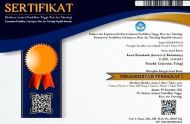RESPON PERTUMBUHAN DAN HASIL SAWI HIJAU TERHADAP PENGGUNAAN KOMPOS SEBAGAI SUBSTITUSI PUPUK ANORGANIK
Abstract
Keywords
Full Text:
PDFReferences
Andriani dan Helda, S., 2017. Pengaruh waktu pemberian dan dosis pupuk kendang sapi terhadap pertumbuhan dan hasil tanaman sawi (Brassica juncea). Agrifor, 16(2): 151-162.
Artha, G.M., Sulistyawati, Sri, H.P., 2018. Efektivitas pemberian pupuk kascing terhadap pertumbuhan dan hasil sawi sendok. Agroteknologi Merdeka Pasuruan, 2(1): 9-15.
Buttler, T.J., Weindorf, D.C., Han, K.J., and Muir, J.P., 2009. Dairy manure compost quality effects on corn silage and soil properties. Compost Science & Utilization, 17 (1): 18-24.
Markwell, J., John, C.O., Jennifer, L.M., 1995. Calibration of the Minolta SPAD-502 leaf chlorophyll meter.Photosynthesis Research 46: 467-472.
Mayun, I.A., Made, A.A.A., Made, S.S., 2022. Respon pertumbuhan dan hasil tanaman sawi hijau terhadap pemberian pupuk organic. Agrotrop, 12(2): 267-273.
Oryschak, M., Chrapko, D., Rawlins, N.H., Jones, S. Korth, C., Kryzonowski, L., Neden, J., Pauly, D., Tremblett, K., and Wallace, T., 2011. Nutrient Management Panning Guide. Alberta Agriculture Food Pobl. Edmonton. Canada.
Rizqiani, N. F., Erlina, A., dan Nasih, W. Y. 2007. Pengaruh Dosis Dan Frekuensi Pemberian Pupuk Organik Cair Terhadap Pertumbuhan Dan Hasil Buncis ( Phaseolus vulgaris L.) Dataran Rendah. Ilmu Tanah dan Lingkungan, 7(1):43;53).
Siregar, I.Z., dan Sri Wilarso, B.R., 2006. Module Pelatihan Kompos 6. ITTO Training Proceedings. ITTO Project. Muara Bulian. Jambi.
Suparhun, S., Muhammad, A., Yohanis, T., 2015. Pengaruh pupk organic dan pupuk poc dari kotoran kambing terhadap pertumbuhan tanaman sawi (Brassica juncea). Agrotekbis, 3(5): 602-611.
Thomas, E. and Reinhold, G. 2001. Nutritional of biowaste composts. Applying Composts Benefits and Needs Seminar Proceedings. Brussels 22-23 November.
Wells, A.T., Chan, K.Y. and Cornish, P.S., 2000. Comparison of conventional and alternative vegetable farming systems on the properties of a yellow earth in New South Wales. Agriculture Ecosystem & Environment, 80(1):47-60.
DOI: https://doi.org/10.31326/jbio.v5i2.1639
Refbacks
- There are currently no refbacks.
Editorial Office:
Fakultas Bioindustri
Universitas Trilogi
Jl. TMP Kalibata No.1
Jakarta 12760
Copyright Notice:











